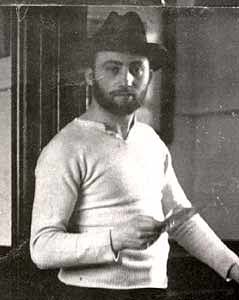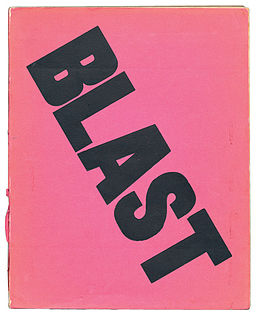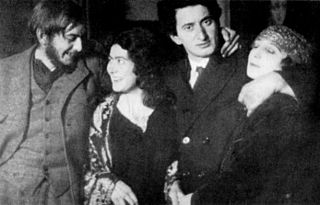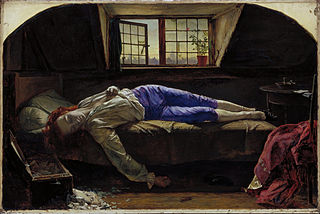
Percy Wyndham Lewis was a British writer, painter, and critic. He was a co-founder of the Vorticist movement in art and edited BLAST, the literary magazine of the Vorticists.

Vorticism was a London-based modernist art movement formed in 1914 by the writer and artist Wyndham Lewis. The movement was partially inspired by Cubism and was introduced to the public by means of the publication of the Vorticist manifesto in Blast magazine. Familiar forms of representational art were rejected in favour of a geometric style that tended towards a hard-edged abstraction. Lewis proved unable to harness the talents of his disparate group of avant-garde artists; however, for a brief period Vorticism proved to be an exciting intervention and an artistic riposte to Marinetti's Futurism and the post-impressionism of Roger Fry's Omega Workshops.

David Garshen Bomberg was a British painter, and one of the Whitechapel Boys.

Blast was the short-lived literary magazine of the Vorticist movement in Britain. Two editions were published: the first on 2 July 1914 and featured a bright pink cover, referred to by Ezra Pound as the "great MAGENTA cover'd opusculus"; and the second a year later on 15 July 1915. Both editions were written primarily by Wyndham Lewis. The magazine is emblematic of the modern art movement in England, and recognised as a seminal text of pre-war 20th-century modernism. The magazine originally cost 2/6.

William Patrick Roberts was a British artist.

Paul Nash was a British surrealist painter and war artist, as well as a photographer, writer and designer of applied art. Nash was among the most important landscape artists of the first half of the twentieth century. He played a key role in the development of Modernism in English art.

Edward Alexander Wadsworth was an English artist, closely associated with modernist Vorticism movement. He painted coastal views, abstracts, portraits and still-life in tempera medium and works printed using wood engraving and copper. In the First World War he designed dazzle camouflage for the Royal Navy, and continued to paint nautical themes after the war.

Jacob Kramer was a Ukrainian-born painter who spent all of his working life in England.

Henry Tonks, FRCS was a British surgeon and later draughtsman and painter of figure subjects, chiefly interiors, and a caricaturist. He became an influential art teacher.

Tate Britain, known from 1897 to 1932 as the National Gallery of British Art and from 1932 to 2000 as the Tate Gallery, is an art museum on Millbank in the City of Westminster in London, England. It is part of the Tate network of galleries in England, with Tate Modern, Tate Liverpool and Tate St Ives. It is the oldest gallery in the network, having opened in 1897. It houses a substantial collection of the art of the United Kingdom since Tudor times, and in particular has large holdings of the works of J. M. W. Turner, who bequeathed all his own collection to the nation. It is one of the largest museums in the country. The museum had 391,595 visitors in 2020, a drop of 78 per cent from 2019 due to COVID-19 pandemic closures, but still ranked 52nd on the list of most-visited art museums in the world.

Russian Ballet is an artist's book by the English artist David Bomberg published in 1919. The work describes the impact of seeing a performance of Diaghilev's Ballets Russes, and is based on a series of drawings Bomberg had done around 1914, while associated with the Vorticist group of avant-garde artists in London. Centred on Wyndham Lewis and Ezra Pound, the movement flourished briefly 1914–1915, before being dispersed by the impact of the First World War. The only surviving example of a vorticist artist's book, the work can be seen as a parody of Marinetti's seminal futurist book Zang Tumb Tumb, using similar language to the Italian's work glorifying war, but instead praising the impact of watching the decidedly less macho Ballets Russes in full flow.
Bomberg was the most audacious painter of his generation at the Slade, proving ... that he could absorb the most experimental European ideas, fuse these with Jewish influences and come up with a robust alternative of his own. His treatment of the human figure, in terms of angular, clear-cut forms charged with enormous energy, reveals his determination to bring about a drastic renewal in British painting. —Richard Cork

Dennis Creffield was a British artist with work owned by major British and worldwide art collections, including the Tate Gallery, The British Museum, Arts Council of England, the Government Art Collection, The Los Angeles County Museum of Art, Leeds City Art Gallery, University of Leeds collection, Williams College Museum of Art, University of Brighton collection, Swindon Art Gallery collection and others.

The Death of Chatterton is an oil painting on canvas, by the English Pre-Raphaelite painter Henry Wallis, now in Tate Britain, London. Two smaller versions, sketches or replicas, are held by the Birmingham Museum and Art Gallery and the Yale Center for British Art. The Tate painting measures 62.2 centimetres (24.5 in) by 93.3 centimetres (36.7 in), and was completed in 1856.

Mario Dubsky was an artist born in London to Viennese Jewish parents who had converted to Christianity.

Merry-Go-Round is a large oil on canvas painting made by Mark Gertler in 1916, when he was 24 years old. It is perhaps his most famous work, and depicts men and women on a merry-go-round ride. The painting may have been inspired by a ride at the annual fair on Hampstead Heath. The painting is now held in Tate Britain.

Lilian Thirza Charlotte Holt (1898–1983) was a British artist, also known by her married name, Bomberg. She was a founding member of the Borough Group. Her dedication to her partner and family limited her career and opportunities as an artist.

We Are Making a New World is a 1918 oil-on-canvas painting by Paul Nash. The optimistic title contrasts with Nash's depiction of a scarred landscape created by a battle of the First World War, with shell-holes, mounds of earth, and leafless tree trunks. Nash's first major painting and his most famous work, it has been described as one of the best British paintings of the 20th century, and compared to Picasso's Guernica. "Yet it is worth remembering that the picture was a piece of official art and that it first appeared, untitled, as the cover of an issue of British War Artists at the Front, published by Country Life. ... [It] was promulgated in 1917 as covert propaganda for the Allied cause."

Horace Ascher Brodzky was an Australian-born artist and writer most of whose work was created in London and New York. His work included paintings, drawings and linocuts, of which he was an early pioneer. An associate in his early career of many leading artists working in Britain of his period, including Henri Gaudier-Brzeska, Mark Gertler, and members of the Vorticism movement, he ended his life relatively neglected.

The Vorticists at the Restaurant de la Tour Eiffel, Spring 1915 is a 1961–1962 painting by the English artist William Roberts. It depicts the Vorticist group gathered at a French restaurant in London.
The Chenil Gallery was a British art gallery and sometime-music studio in Chelsea, London between 1905 and 1927, and later the location of various businesses referencing this early use.




















